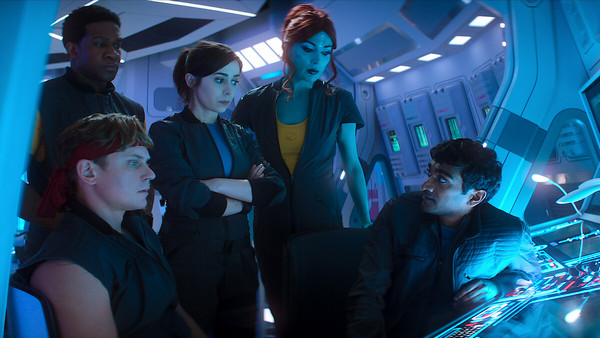Proper Gander – Looking into Black Mirror
 While the stories in Netflix’s Black Mirror tend to be set in the near future, its roots are set squarely in the past. When the series debuted on Channel 4 in 2011, it revived the long-neglected format of a drama anthology, and has carried on the tradition of science fiction enabling us to explore the consequences of technological advances for people and society, especially before they arrive.
While the stories in Netflix’s Black Mirror tend to be set in the near future, its roots are set squarely in the past. When the series debuted on Channel 4 in 2011, it revived the long-neglected format of a drama anthology, and has carried on the tradition of science fiction enabling us to explore the consequences of technological advances for people and society, especially before they arrive.
The tales in Black Mirror’s latest series (its seventh) share some themes, discussion of which below will reveal plot details. Creating virtual worlds (the computer games in the episodes ‘Plaything’ and ‘USS Callister: Into Infinity’, and the immersive media in ‘Eulogy’ and ‘Hotel Reverie’) is a recurring motif, as is a digital avatar of someone, inhabiting either those alternative realities or interacting with the outside world. Their use is linked to recreating the past in all these episodes, underlining the bleak view of the future throughout the series. Showrunner Charlie Brooker’s outlook tends to be pessimistic not with technology itself, but rather with how it is used by institutions or by damaged people. The bitter, alienated IT expert is Black Mirror’s version of the mad scientist trope. Misfit computer geeks using their know-how to get power over those they have learned to resent drives the plots of ‘Bête Noire’, ‘Plaything’ and ‘USS Callister’, the 2017 episode which has gained a sequel in this series.
The use of tech to exploit and control other people runs through Black Mirror like words in a stick of rock. In some episodes, the technological innovation offers more positive experiences. In ‘Eulogy’, AI allows people to virtually inhabit old photographs, while ‘Hotel Reverie’ ups the ante to entering old films and interacting with their characters. While this technology remains science fiction, AI is already blurring our understanding of what’s real, and Black Mirror is as much a thought experiment as a drama. From a more grounded perspective, ‘Hotel Reverie’ gets some digs in at the entertainment industry, being set in a cynical production studio churning out another reboot of a classic film as an anticipated source of revenue.
The episode with the largest helping of satire about the relationship between commerce and technology is ‘Common People’. Its premise is that a woman in a coma is able to have a new treatment to replace the damaged part of her brain with a digital backup, restoring her consciousness with the promise of living a normal life again. Rivermind, the new treatment, comes as a subscription package, and she and her husband learn that she is on a basic tariff with a restricted coverage area, making her shut down when she travels out of the signal’s range. When she involuntarily starts speaking adverts ‘designed to be contextually relevant to the situation you are in’, they decide to switch to the more expensive and expansive ad-free Rivermind Plus package. To afford this, the husband resorts to performing humiliating acts for money on a livestreaming platform. The couple struggles further to maintain a decent lifestyle when the Plus tariff gets superseded by the premium Lux tariff, and their hoped-for pregnancy would incur additional fees now out of their reach.
Despite its sci-fi and dystopian trappings, the scenario is more realistic than it might first appear. The adverts which the woman spouts out aren’t much different to those which some podcasters and vloggers interrupt their spiel with as if that’s a natural part of discussion. And the ‘trash streaming’ site featured unfortunately has real-world counterparts, particularly in Russia apparently. Rivermind is also realistic to the extent that it uses ‘platform decay’ as a strategy to maintain its customers. This is when the quality of an online service or product deliberately declines over time. Punters are initially drawn in by an attractive offer, which then gets superseded by a supposedly improved, pricier upgrade, degrading the original deal. The customer is then tempted to pay more to get the updated version. One service which has been subject to ‘platform decay’ is Netflix, and hopefully Brooker slipped in this critique intentionally. Once the brand became a market leader among streaming sites, it discontinued its cheapest advert-free tariff, effectively raising prices even though its number of subscribers already ensured a hefty income.
Netflix’s accountants wouldn’t be too bothered if the bulk of its customers remained on tariffs which include adverts, though, as this means a wide audience as a basis to charge a high amount when selling advert space. The company’s dominance in the market means that it has created loyal customers who remain so despite some ‘platform decay’, and who also provide plenty of behavioural data to be used to exploit their preferences. As always in capitalism, how a service is run and delivered is shaped by what maximises profits, rather than by what works best for all those involved. In ‘Common People’, when the fictional Rivermind applies the commercial prerogatives of a subscription package to someone’s life, it’s an extrapolation of what’s already familiar. The sub-plot of the trash streaming site is another amplification to show the extremes of what people can be forced to do to make ends meet. As an illustration of how the money system rules how we live, ‘Common People’ presents the argument in a stronger way than most documentaries.
MIKE FOSTER
